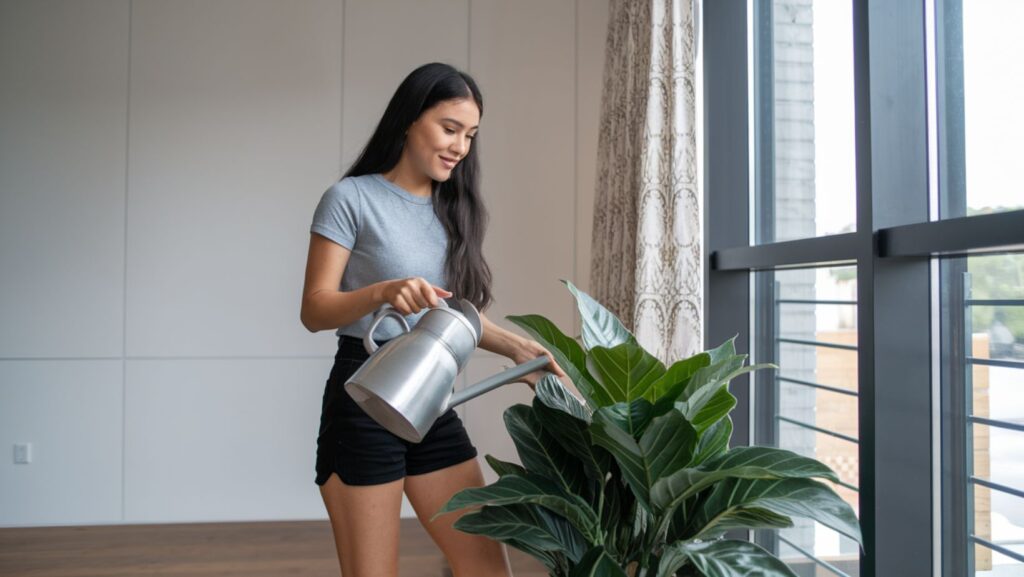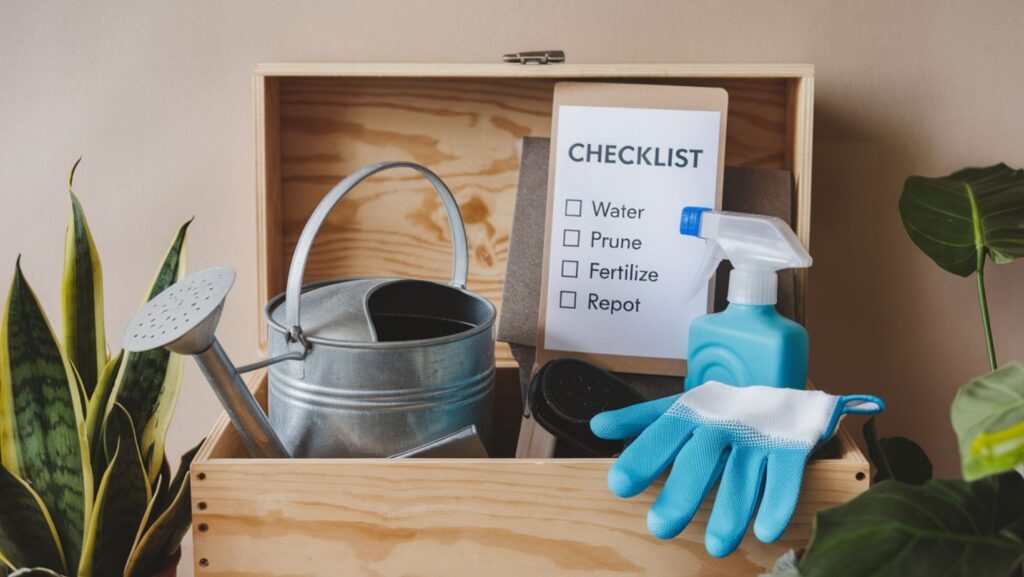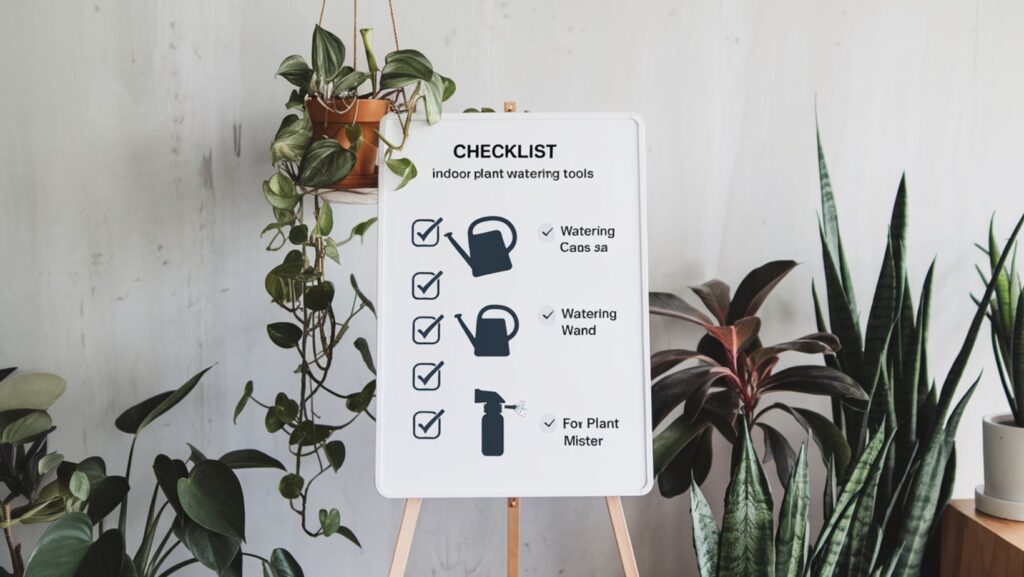Learning to water indoor plants right is crucial for their health. Too much or too little water can damage even the toughest plants. This guide makes watering easier. It helps roots get the nutrients and water they need, avoiding wilting or root rot.
Whether you’re new to gardening or have been doing it for years, knowing how to water is key. It turns struggling plants into beautiful, healthy ones.
Many gardeners get confused about when and how much to water. This guide helps fix common mistakes and gives clear steps. You’ll learn to check soil dryness, pick the right tools, and adjust for the seasons.
Every plant is different, and this guide uses science to help you succeed. It breaks down the best methods for each plant.
Key Takeaways
- Proper watering is the foundation of healthy indoor plants.
- Overwatering and underwatering cause most plant problems.
- Soil type and environmental conditions affect moisture needs.
- Tools like moisture meters simplify care routines.
- Adjusting schedules based on plant type and season ensures growth.
Understanding the Importance of Proper Watering Plants Indoor
Proper watering is key to indoor plant care. Plants need water to grow well. Knowing how to water indoor plants properly is crucial. Water helps plants grow strong, but too much or too little can harm them.
How Water Affects Plant Health
Water carries nutrients to plants, keeping them healthy. It helps plants make food through photosynthesis. Without enough water, plants can’t grow well.
The Relationship Between Water, Soil, and Roots
Soil type affects how water is absorbed. Clay soils hold water longer, while sandy soils drain fast. Roots need air, so too much water can harm them.
- Clay soil: retains water, risks overhydration
- Sandy soil: drains fast, requires frequent watering
- Loamy soil: ideal mix for most houseplants
Common Consequences of Improper Watering
Too much water can kill roots, causing yellow leaves and diseases. Not enough water makes leaves dry and plants grow slowly. Both problems can make plants sick and attract pests.
Signs Your Indoor Plants Need Water
Learning indoor plant care begins with knowing when to water. Look out for these signs that your plants need water:
- Wilting leaves—soft, drooping leaves often mean they’re thirsty.
- Leaf edges browning—dry, crispy edges can show dehydration.
- Soil color changes—if the soil on top looks light and dry, it’s low on moisture.
- Curling leaves—some plants, like African violets, curl their leaves when they’re dry.
Try the finger test to see if the soil is dry: stick your finger 1–2 inches into the soil. If it feels dry, it’s time to water. For big pots, lifting them can tell you if the roots are dry. Watch for these signs specific to each plant:
| Plant Type | Thirst Signal | Action |
|---|---|---|
| Succulents | Shrinking or wrinkled leaves | Water sparingly, soak thoroughly |
| Peace Lily | Yellowing leaves | Water deeply once a week |
| Fiddle Leaf Fig | Leaves drooping | Water until liquid drains from pot |
Regular checks and indoor plant watering tips can prevent stress. Adjust your watering schedule based on the plant type and its environment for better growth.
Recognizing Symptoms of Overwatering vs. Underwatering
It’s important to know the difference between overwatering and underwatering to save your indoor plants. Spotting these signs helps you water them right to avoid damage.
Visible Signs of Overwatered Plants
- Yellowing leaves at the base, especially new growth
- Soft, mushy stems that collapse when touched
- Mold growth on soil surface or foul odor
- Presence of fungus gnats swarming the pot
Telltale Indicators of Underwatering
- Crispy, brown leaf edges that crumble easily
- Soil pulling away from the pot’s edges
- Wilting leaves that don’t recover after watering
- Slow growth or premature leaf drop
Recovery Techniques for Both Conditions
| Issue | Overwatering Recovery | Underwatering Recovery |
|---|---|---|
| Step 1 | Let soil dry completely before next watering | Soak soil thoroughly, then resume regular schedule |
| Step 2 | Repot plant with fresh, well-draining soil | Mist leaves daily to restore moisture |
| Step 3 | Trim rotted roots to prevent decay spread | Increase humidity with pebble trays |
Getting the right diagnosis is key to saving your plants. Always check the soil moisture and adjust your watering schedule. Sticking to the best watering practices keeps your plants healthy for a long time.
Essential Tools for Proper Indoor Plant Watering
Starting with the right tools is key to caring for indoor plants. These tools help create a nurturing space for your plants to grow. Find the tools that fit your routine and the needs of your plants.
Types of Watering Cans and Their Uses
Watering cans are designed for different types of plants. Here are a few:
- Long-spout cans are great for hanging plants without making a mess.
- Misting attachments help mimic the humid air tropical plants love.
- Graduated cans have marks to help you water just the right amount.
Moisture Meters and Their Benefits
Moisture meters make watering easier. Digital models like the Goumate Soil Moisture Meter or analog tools like the Luster Leaf TRC-10 show how wet the soil is. It’s important to test in different spots because soil types can affect readings. These tools are crucial for precise watering.
“A moisture meter is the closest thing to a plant’s voice.”
Self-Watering Systems for Busy Plant Parents
Got a busy schedule? Self-watering systems are perfect. Wicking systems draw water up from reservoirs. Smart pots like the Self-Watering Planter by AeroGarden even water for you. These systems are great for those who travel or have many plants.
Different Watering Techniques for Various Indoor Plants
Learning how to water indoor plants properly begins with knowing their natural homes. Plants from the tropics, like ferns, love humid air. On the other hand, cacti do best in dry environments. Tailor your watering methods to meet these needs for better plant health.
- Bottom Watering: Put pots in a water tray for 15–30 minutes. This is great for fiddle leaf figs to avoid leaf damage.
- Top Watering: Use this for succulents, letting any extra water drain off. It helps prevent root rot in plants that don’t like too much moisture.
- Misting: Spray the leaves of peace lilies or spider plants once a week. This mimics their natural humid habitats.
| Plant Type | Best Method | Frequency |
|---|---|---|
| Tropical (e.g., Boston fern) | Misting + top watering | Mist 2x/week, water when top 1″ soil dries |
| Succulents/Cacti | Deep watering every 2–3 weeks | Soak soil thoroughly, let dry completely |
| Air Plants | Submerge in water 1x/week | Soak 2–3 hours, shake dry, and air-dry upside down |
| Orchids | Ice cube method or bark medium watering | 3 ice cubes/week or water every 7–10 days |
Change best watering practices for indoor plants based on pot size. Smaller pots dry out faster. Young plants or those in growth phases might need more water checks. Always consider the plant’s natural environment over a generic watering schedule.
Creating an Effective Indoor Plant Watering Schedule
Creating a good watering schedule for indoor plants means being consistent yet flexible. Plants need routines that change with the seasons, room conditions, and technology. Start by watching your plants to make a plan that fits them.
Seasonal Adjustments to Your Watering Routine
In spring and summer, plants grow fast and need more water. In fall and winter, they grow slower and need less. Succulents might need water every two weeks in winter, while tropical plants like pothos still need water weekly. Keep track of these changes on a calendar to avoid too much water during slow periods.
- In spring/summer: Check soil weekly; adjust based on plant type.
- In fall/winter: Cut watering by half. Let soil dry fully between sessions.
Adapting to Environmental Conditions
Light, humidity, and room temperature affect how fast soil dries. Rooms with low humidity might need more water. Sunny spots dry out soil faster, while drafty areas slow down water loss. Here’s a guide:
- High light = more frequent checks every 3-4 days.
- Low humidity? Increase watering frequency by 20-30%.
Using Technology to Track Watering Needs
“Smart systems save time by analyzing moisture levels automatically.” – Gardena Innovations
Apps like Flowerence send reminders based on your plants. Soil sensors like Gardena Smart Sensors tell you when to water. Use these tools with your own checks for the best results. Keep track of your plants’ needs over time to improve your indoor plant watering frequency.
Water Quality Considerations for Houseplants
Healthy indoor plants need more than just the right watering schedule. Best watering practices for indoor plants include using water that supports root health and nutrient absorption. Poor water quality can cause stunted growth or leaf discoloration, even with proper indoor plant care.
Tap Water vs. Filtered Water vs. Rainwater
Tap water often has chlorine and fluoride, which can harm plants like ferns or orchids. Filtered or distilled water removes these chemicals, helping prevent leaf browning. Rainwater is great for most plants but might not be available all year. Here are some options:
- Let tap water sit uncovered 24 hours to evaporate chlorine
- Use filtered water for tropical plants like peace lilies
- Collect rainwater in clean containers during rainy seasons
Water Temperature Effects
Cold tap water can shock roots, especially for tropical plants. Aim for lukewarm (65-75°F/18-24°C) water to match indoor temperatures. Avoid pouring ice-cold water, as it can stress roots. Warm water helps with nutrient uptake in plants that love humidity.
Addressing Hard Water Issues
Hard water leaves a white crust on soil surfaces due to mineral buildup. This blocks oxygen flow to roots. Solutions include:
- Flushing soil monthly with filtered water
- Using soft water for succulents and citrus plants
- Applying calcium-magnesium amendments for affected soil
Improving water quality ensures nutrients reach roots effectively. These adjustments are simple but crucial for maintaining thriving indoor gardens.
Special Watering Needs for Different Plant Categories
Adjust your watering habits based on the type of plant you have. This ensures they stay healthy. Here’s a guide for different plant groups:
- High-Water-Need Plants: Ferns, peace lilies, and calatheas love moist soil. Water when the top inch of soil feels dry. Make sure pots have holes for water to drain. Water more often when they’re growing fast to prevent too much water.
- Drought-Tolerant Plants: Succulents, cacti, and ZZ plants keep water in their leaves. Wait until the soil is completely dry before watering. Water less in winter to avoid root rot.
- Epiphytic Plants: Orchids and air plants get moisture through their roots or leaves. Mist air plants every week and give orchids a quick soak. Use a humidity tray for plants that love wet air.
- Seasonal Bloomers: Poinsettias and cyclamen need less water when they’re not growing. Start watering regularly when they start growing again.
Watch for signs like yellow leaves or droopy plants. Change your watering ways based on the plant type to keep them healthy.
Conclusion: Mastering the Balance of Moisture for Thriving Indoor Plants
Creating a good watering schedule is key for indoor plants to thrive. This guide has shown you how to check soil moisture and spot when plants need help. It’s important to be flexible because each plant is different.
Use tools like moisture meters to help, but don’t forget the importance of regular checks. Make sure your plants get enough light, humidity, and food too. As you get to know your plants, watering will become easier and help them grow well.
Even small changes, like using filtered water or watering less in summer, can help a lot. Share your experiences and ask for tips. Your plants will thank you with beautiful leaves and a long life. Start with this guide and watch your indoor garden flourish.
Frequently Asked Questions
What are the best watering practices for indoor plants?
For indoor plants, it’s key to know their water needs. Use pots that drain well and check the soil before watering. Avoid a set watering schedule and check moisture levels often.
How often should I water my indoor plants?
Watering frequency varies by plant type, pot size, and environment. Most plants do well with watering every 5 to 14 days. Always check the soil moisture first to avoid too much water.
How can I tell if my indoor plants are underwatered?
Underwatered plants show signs like wilting leaves and dry soil. The finger test can help: stick your finger into the soil up to two inches. If it’s dry, it’s time to water.
What tools can help with my indoor plant care?
Key tools include moisture meters, watering cans with long spouts, and self-watering systems. These help keep plants hydrated, especially for those with busy schedules.
What water quality should I use for watering indoor plants?
Use filtered or rainwater for your plants to avoid chemicals in tap water. If tap water is your only option, let it sit overnight to reduce harmful substances.
What are the signs of overwatering in indoor plants?
Overwatering shows as yellow leaves, a moldy soil surface, and root rot. If your plants are always soggy and leaves are mushy, cut back on watering right away.
How can I maintain an effective indoor plant watering schedule?
To keep a good watering schedule, adjust for seasons and watch environmental changes. Use plant care apps to track watering needs efficiently.
Are certain plants more difficult to water than others?
Yes, some plants like ferns need moist soil, while succulents prefer less water. Knowing each plant’s needs is key to caring for them well.


